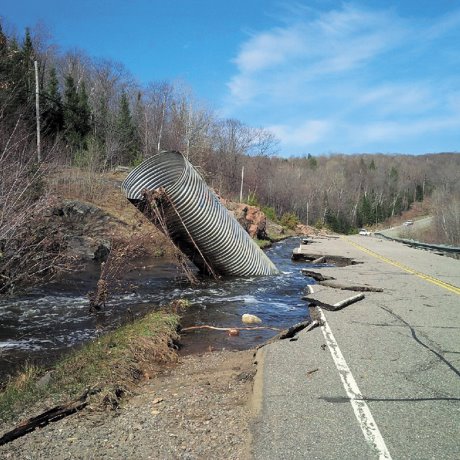July 25, 2017: A large stretch of Renfrew County Road 30, both asphalt and roadbed, disappear overnight.
April 1, 2016: Two cars on Highway 141 in Muskoka, Ont. plunge into a submerged crevasse drivers believed was simply a flooded roadway.
Though each road was damaged by a mad rush of water, the flood could be traced to a single cause — the collapse of a dam built by beavers.
No foul to the beavers. Their diligent dam building helps create beneficial wetlands and encourages bio-diversity. However, like all real estate, the location of dams is critical.
"Beavers are very industrious and love to stop the flow of water," says John Potts, maintenance superintendent at the Ontario Ministry of Transportation’s (MTO) Bancroft office. "We often have beavers working alongside our highways."
The highway right-of-way extends 30 metres out from the fender line, where beavers are likely to build dams at the ends of culverts to create feed beds — a supply of greens preserved for winter nourishment.
"During routine inspection, our maintenance contractors report the visual indicators that a beaver dam is under construction," he says. "Typically, they see a ditch backing up or a pond forming. Over a few days beavers can build a pretty healthy dam."
Maintenance workers disassemble small dams using long-handled rakes. Larger dams typically found in spring can require the use of a backhoe or excavator.
"The strategy is to take the dam down gradually," says Potts. "That allows a slow release of water to avoid downstream damage."
A 2005 study, the geomorphic influences of beaver dams and failures of beaver dams, by David R. Butler of Texas State University, notes a well-constructed beaver dam can last for decades. "Catastrophic failure" of beaver dams is usually the result of flooding that exceeds their structural capacity. That can be caused by rainfall, snowmelt or the collapse of dams further upstream.
Dams can also fail because other animals burrow through them, or because people attempt to dismantle part of the structure.
When dams break, they also release sediment. A dam can trap as much as a billion cubic metres. According to the study, dam breaks have released enough force to move granite boulders a metre in diameter up to 100 metres downstream.
Potts notes a recent beaver dam collapse in July caused a washout on Highway 28 near Bancroft. A vacationing OPP officer noticed the hazard and notified officers to attend the flood site. The flooding continued for 12 hours, taking out the highway shoulder and guiderails.
"We also had a beaver dam break on Crown land this spring on Highway 118 towards Cardiff," he says. "The water came down a hill, hit a hollow and the force of the water scoured out the road, then took out the pavement, a culvert and guiderails. There’s still grass, swamp mud and debris caught in the trees as high as 15 or 20 feet where the water came through the woods and over the highway."
If dams are located on Crown land, the MTO discusses control strategies with the Ministry of Natural Resources and Forestry (MNRF), including trapping of "nuisance" beavers. MTO may also contact a private property owner if beaver construction is evident.
Jolanta Kowalski, an MNRF spokesperson, notes that neither her ministry nor the MTO remove beavers from private property. However, removing a dam in such a way as to cause flooding, or simply leaving it in place until it collapses, can trigger legal consequences for property owners.
"You may be held liable for property damage that occurs downstream," she says. "MNRF provides advice on making your property unwelcome to beavers, and can provide contact information for authorized wildlife agents. By educating the public on techniques to reduce human-beaver conflict, such as fencing of trees, it prevents the killing of beavers and discourages the natural migration of new animals into the same area."
Potts says he admires the industriousness of beavers and respects the impressive force of water and sediment released when a dam bursts.
"Typically we experience one dam break per year and some of them are not very significant," he says. "But I wouldn’t want to be driving through the area at the moment a big dam lets loose."



Recent Comments
comments for this post are closed